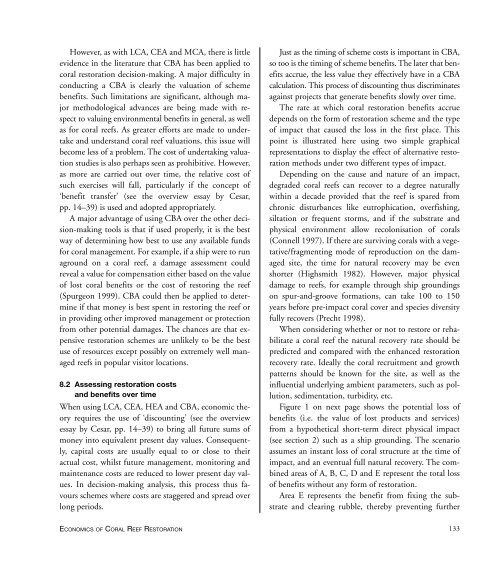Create successful ePaper yourself
Turn your PDF publications into a flip-book with our unique Google optimized e-Paper software.
However, as with LCA, CEA and MCA, there is little<br />
evidence in the literature that CBA has been applied to<br />
coral restoration decision-making. A major difficulty in<br />
conducting a CBA is clearly the valuation <strong>of</strong> scheme<br />
benefits. Such limitations are significant, although major<br />
methodological advances are being made with respect<br />
to valuing environmental benefits in general, as well<br />
as for coral reefs. As greater efforts are made to undertake<br />
and understand coral reef valuations, this issue will<br />
become less <strong>of</strong> a problem. The cost <strong>of</strong> undertaking valuation<br />
studies is also perhaps seen as prohibitive. However,<br />
as more are carried out over time, the relative cost <strong>of</strong><br />
such exercises will fall, particularly if the concept <strong>of</strong><br />
‘benefit transfer’ (see the overview essay by Cesar,<br />
pp. 14–39) is used and adopted appropriately.<br />
A major advantage <strong>of</strong> using CBA over the other decision-making<br />
tools is that if used properly, it is the best<br />
way <strong>of</strong> determining how best to use any available funds<br />
for coral management. For example, if a ship were to run<br />
aground on a coral reef, a damage assessment could<br />
reveal a value for compensation either based on the value<br />
<strong>of</strong> lost coral benefits or the cost <strong>of</strong> restoring the reef<br />
(Spurgeon 1999). CBA could then be applied to determine<br />
if that money is best spent in restoring the reef or<br />
in providing other improved management or protection<br />
from other potential damages. The chances are that expensive<br />
restoration schemes are unlikely to be the best<br />
use <strong>of</strong> resources except possibly on extremely well managed<br />
reefs in popular visitor locations.<br />
8.2 Assessing restoration costs<br />
and benefits over time<br />
When using LCA, CEA, HEA and CBA, economic theory<br />
requires the use <strong>of</strong> ‘discounting’ (see the overview<br />
essay by Cesar, pp. 14–39) to bring all future sums <strong>of</strong><br />
money into equivalent present day values. Consequently,<br />
capital costs are usually equal to or close to their<br />
actual cost, whilst future management, monitoring and<br />
maintenance costs are reduced to lower present day values.<br />
In decision-making analysis, this process thus favours<br />
schemes where costs are staggered and spread over<br />
long periods.<br />
ECONOMICS OF CORAL REEF RESTORATION<br />
Just as the timing <strong>of</strong> scheme costs is important in CBA,<br />
so too is the timing <strong>of</strong> scheme benefits. The later that benefits<br />
accrue, the less value they effectively have in a CBA<br />
calculation. This process <strong>of</strong> discounting thus discriminates<br />
against projects that generate benefits slowly over time.<br />
The rate at which coral restoration benefits accrue<br />
depends on the form <strong>of</strong> restoration scheme and the type<br />
<strong>of</strong> impact that caused the loss in the first place. This<br />
point is illustrated here using two simple graphical<br />
representations to display the effect <strong>of</strong> alternative restoration<br />
methods under two different types <strong>of</strong> impact.<br />
Depending on the cause and nature <strong>of</strong> an impact,<br />
degraded coral reefs can recover to a degree naturally<br />
within a decade provided that the reef is spared from<br />
chronic disturbances like eutrophication, overfishing,<br />
siltation or frequent storms, and if the substrate and<br />
physical environment allow recolonisation <strong>of</strong> corals<br />
(Connell 1997). If there are surviving corals with a vegetative/fragmenting<br />
mode <strong>of</strong> reproduction on the damaged<br />
site, the time for natural recovery may be even<br />
shorter (Highsmith 1982). However, major physical<br />
damage to reefs, for example through ship groundings<br />
on spur-and-groove formations, can take 100 to 150<br />
years before pre-impact coral cover and species diversity<br />
fully recovers (Precht 1998).<br />
When considering whether or not to restore or rehabilitate<br />
a coral reef the natural recovery rate should be<br />
predicted and compared with the enhanced restoration<br />
recovery rate. Ideally the coral recruitment and growth<br />
patterns should be known for the site, as well as the<br />
influential underlying ambient parameters, such as pollution,<br />
sedimentation, turbidity, etc.<br />
Figure 1 on next page shows the potential loss <strong>of</strong><br />
benefits (i.e. the value <strong>of</strong> lost products and services)<br />
from a hypothetical short-term direct physical impact<br />
(see section 2) such as a ship grounding. The scenario<br />
assumes an instant loss <strong>of</strong> coral structure at the time <strong>of</strong><br />
impact, and an eventual full natural recovery. The combined<br />
areas <strong>of</strong> A, B, C, D and E represent the total loss<br />
<strong>of</strong> benefits without any form <strong>of</strong> restoration.<br />
Area E represents the benefit from fixing the substrate<br />
and clearing rubble, thereby preventing further<br />
133


















